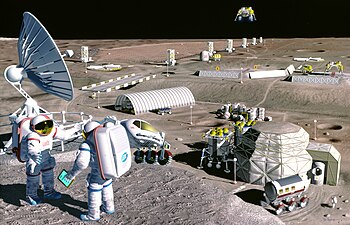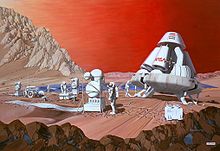Space colonization
Many arguments have been made for space colonization.[1] The two most common are survival of human civilization and the biosphere in case of a planetary-scale disaster (natural or man-made), and the vast resources in space for expansion of human society.[citation needed]
No space colonies have been built so far. As of right now, the building of a space colony would present a set of huge challenges, both technological and economic. Space settlements would have to provide for nearly all (or all) the material needs of hundreds or thousands of humans, in an environment out in space that is very hostile to human life.[citation needed] They would involve technologies, such as controlled ecological life support systems, that have yet to be developed in any meaningful way. They would also have to deal with the as yet unknown issue of how humans would behave and thrive in such places long-term. Because of the huge cost of sending anything from the surface of the Earth into orbit (roughly $20,000 USD per kilogram) a space colony would be a massively expensive project.
There are no timetables for building one by any large-scale organization (either government or private). However, there have been many proposals, speculations, and designs for space settlements that have been made, and there are a considerable number of space colonization advocates and groups. And several famous scientists, such as Freeman Dyson, have come out in favor of space settlement.[2]
Also on the technological front, there is ongoing progress in making access to space cheaper, and in creating automated manufacturing and construction techniques.[citation needed] This could in the future lead to widespread space tourism, which could be a stepping stone to space colonization.[citation needed]
Contents
- 1 Reasons
- 2 Goals
- 3 Space colony types
- 4 Method
- 5 Location
- 6 Funding
- 7 Terrestrial analogues to space colonies
- 8 History
- 9 Objections
- 10 Involved organizations
- 11 In fiction
- 12 See also
- 13 References
- 14 Further reading
Reasons
Survival of human civilization
Theoretical physicist and cosmologist Stephen Hawking has argued for space colonization as a means of saving humanity, in 2001 and 2006. In 2001 he predicted that the human race would become extinct within the next thousand years, unless colonies could be established in space.[3] The more recent one in 2006 stated that mankind faces two options: Either we colonize space within the next two hundred years and build residential units on other planets or we will face the prospect of long-term extinction.[4]
Louis J. Halle, formerly of the United States Department of State, wrote in Foreign Affairs (Summer 1980) that the colonization of space will protect humanity in the event of global nuclear warfare.[5] The physicist Paul Davies also supports the view that if a planetary catastrophe threatens the survival of the human species on Earth, a self-sufficient colony could "reverse-colonize" Earth and restore human civilization. The author and journalist William E. Burrows and the biochemist Robert Shapiro proposed a private project, the Alliance to Rescue Civilization, with the goal of establishing an off-Earth backup of human civilization.[6]
J. Richard Gott has estimated, based on his Copernican principle, that the human race could survive for another 7.8 million years, but it isn't likely to ever colonize other planets. However, he expressed a hope to be proven wrong, because "colonizing other worlds is our best chance to hedge our bets and improve the survival prospects of our species".[7]
Survival of the biosphere
Many of the same existential risks to humankind would destroy parts or all of Earth's biosphere as well. An example would be a very large asteroid impact. And although many have speculated about life and intelligence existing in other parts of space, Earth is the only place in the universe currently known to harbor either of these (see: Fermi Paradox, and Rare Earth Hypothesis).But even if these threats are averted, eventually Earth is to become uninhabitable. This is due to the Sun's increasing luminosity over its lifetime: the Sun is estimated to have been 70-75 percent as bright as it is now when it first formed 4.5 billion years ago, and in a billion years it will be 10 percent brighter. It has been suggested that approximately 800 million years from now, that Earth will cease to be able to sustain multi-cellular life.[8] Later on in several billion years, the brightening Sun will cause a runaway greenhouse effect, extinguishing all life on Earth.
Vast resources in space
Resources in space, both in materials and energy, are enormous. The Solar System alone has, according to different estimates, enough material and energy to support numbers of humans, anywhere from several thousand to over a billion times that of the current Earth-based human population.[9][10][11] Outside the Solar System in the Milky Way are anywhere up to several hundred billion other stellar systems. Outside the Milky Way are up to several hundred billion other galaxies in the observable universe.Expansion with fewer negative consequences
Expansion of humans and technological progress has usually resulted in some form of environmental devastation, and destruction of ecosystems and their accompanying wildlife.The Earth right now has entered another mass extinction event, similar to the one 65 million years ago that wiped out the dinosaurs. The reason for this new mass extinction: us (humans).[12][13]Aside from Earth's, there are no currently known biospheres to destroy in space.
Expansion has also often come at the expense of displacing many indigenous peoples, the resulting treatment of these peoples ranging anywhere from encroachment to full-blown genocide. Since space has no indigenous peoples this need not be a consequence, as some space settlement advocates have pointed out.[14][15]
Could help Earth
Another argument for space colonization is to mitigate the negative effects of overpopulation. If the resources of space were opened to use and viable life-supporting habitats were built, Earth would no longer define the limitations of growth. Although Earth's resources do not grow, humans more and more learn to exploit them effectively, and sometimes even almost completely. As extraterrestrial resources become available, demand on terrestrial ones would decline.[16]Other arguments
Additional goals cite the innate human drive to explore and discover, a quality recognized at the core of progress and thriving civilizations.[17][18]Nick Bostrom has argued that from a utilitarian perspective, space colonization should be a chief goal as it would enable a very large population to live for a very long period of time (possibly billions of years) which would produce an enormous amount of utility (or happiness). He claims that it is more important to reduce existential risks to increase the probability of eventual colonization than to accelerate technological development so that space colonization could happen sooner.[19] In his paper, he assumes that the created lives will have positive ethical value despite the problem of suffering, or that future technology could solve it.
In a 2001 interview with Freeman Dyson, J. Richard Gott and Sid Goldstein, they were asked for reasons why some humans should live in space.[2] Their answers were:
- Spread life and beauty throughout the universe
- Ensure the survival of our species
- Make money through new forms of space commercialization such as solar-power satellites, asteroid mining, and space manufacturing
- Save the environment of Earth by moving people and industry into space
- Provide entertainment value in order to distract from immediate surroundings, space tourism
- Ensure sufficient supply of rare materials, including from the outer Solar System—natural gas (in connection with expected worldwide hydrocarbons peak) and drinking water (in connection with expected worldwide water shortage).
Goals
There will be a very high initial investment cost for space colonies and any other permanent space infrastructure due to the high cost of getting into space. However, proponents argue that the long-term vision of developing space infrastructure will provide long-term benefits far in excess of the initial start-up costs. Therefore, such a development program should be viewed more as a long-term investment and not like current social spending programs that incur spending commitments but provide little or no return on that investment.Because current space launch costs are so high ($4,000 to $40,000 per kilogram), any serious plans for space colonization must include developing low-cost access to space followed by developing in-situ resource utilization. Therefore, the initial investments must be made in the development of low-cost access to space followed by an initial capacity to provide these necessities: materials, energy, propellant, communication, life support, radiation protection, self-replication, and population.
Although some items of the infrastructure requirements above can already be easily produced on Earth and would therefore not be very valuable as trade items (oxygen, water, base metal ores, silicates, etc.), other high value items are more abundant, more easily produced, of higher quality, or can only be produced in space. These would provide (over the long-term) a very high return on the initial investment in space infrastructure.[20]
Some of these high-value trade goods include precious metals,[21][22] gem stones,[23] power,[24] solar cells,[25] ball bearings,[25] semi-conductors,[25] and pharmaceuticals.[25]
| “ | ... the smallest Earth-crossing asteroid 3554 Amun ... is a mile-wide (2 km) lump of iron, nickel, cobalt, platinum, and other metals; it contains 30 times as much metal as Humans have mined throughout history, although it is only the smallest of dozens of known metallic asteroids and worth perhaps US$ 20 trillion if mined slowly to meet demand at 2001 market prices.[21] | ” |
Potential sites for space colonies include the Moon, Mars, asteroids and free-floating space habitats. Ample quantities of all the necessary materials, such as solar energy and water, are available from or on the Moon, Mars, near-Earth asteroids or other planetary bodies.
In 2005, then NASA Administrator Michael Griffin identified space colonization as the ultimate goal of current spaceflight programs, saying:
| “ | ... the goal isn't just scientific exploration ... it's also about extending the range of human habitat out from Earth into the solar system as we go forward in time ... In the long run a single-planet species will not survive ... If we humans want to survive for hundreds of thousands or millions of years, we must ultimately populate other planets. Now, today the technology is such that this is barely conceivable. We're in the infancy of it. ... I'm talking about that one day, I don't know when that day is, but there will be more human beings who live off the Earth than on it. We may well have people living on the Moon. We may have people living on the moons of Jupiter and other planets. We may have people making habitats on asteroids ... I know that humans will colonize the solar system and one day go beyond. | ” |
| “ | In the 2,900 km³ of Eros, there is more aluminium, gold, silver, zinc and other base and precious metals than have ever been excavated in history or indeed, could ever be excavated from the upper layers of the Earth's crust.[23] | ” |
Major governments and well-funded corporations have announced plans for new categories of activities: space tourism and hotels, prototype space-based solar-power satellites, heavy-lift boosters and asteroid mining—that create needs and capabilities for humans to be in space.[32][33][34]
In particular, progresses with the annihilation of matter could render spaceflight and colonization more efficient and affordable, to a revolutionary degree,[35] and nuclear engineering.[36]
Space colony types
There are two main types of space colonies:- Surface-based examples that would exist on or below the surfaces of planets, moons, etc.
- Space habitats — free-floating stations that would orbit a planet, moon, etc. or in an independent orbit around the sun.
Space habitats
Method
Building colonies in space would require access to water, food, space, people, construction materials, energy, transportation, communications, life support, simulated gravity, radiation protection and capital investment. It is likely the colonies would be located by proximity to the necessary physical resources. The practice of space architecture seeks to transform spaceflight from a heroic test of human endurance to a normality within the bounds of comfortable experience. As is true of other frontier opening endeavors, the capital investment necessary for space colonization would probably come from the state,[37] an argument made by John Hickman[38] and Neil deGrasse Tyson.[39]Materials
Colonies on the Moon, Mars, or asteroids could extract local materials. The Moon is deficient in volatiles such as argon, helium and compounds of carbon, hydrogen and nitrogen. The LCROSS impacter was targeted at the Cabeus crater which was chosen as having a high concentration of water for the Moon. A plume of material erupted in which some water was detected. Anthony Colaprete estimated that the Cabeus crater contains material with 1% water or possibly more.[40] Water ice should also be in other permanently shadowed craters near the lunar poles. Although helium is present only in low concentrations on the Moon, where it is deposited into regolith by the solar wind, an estimated million tons of He-3 exists over all.[41] It also has industrially significant oxygen, silicon, and metals such as iron, aluminum, and titanium.Launching materials from Earth is expensive, so bulk materials for colonies could come from the Moon, a near-Earth object, Phobos, or Deimos. The benefits of using such sources include: a lower gravitational force, there is no atmospheric drag on cargo vessels, and there is no biosphere to damage. Many NEOs contain substantial amounts of metals. Underneath a drier outer crust (much like oil shale), some other NEOs are inactive comets which include billions of tons of water ice and kerogen hydrocarbons, as well as some nitrogen compounds.[42]
Farther out, Jupiter's Trojan asteroids are thought to be high in water ice and other volatiles.[43]
Recycling of some raw materials would almost certainly be necessary.
Energy
Solar energy in orbit is abundant, reliable, and is commonly used to power satellites today. There is no night in free space, and no clouds or atmosphere to block sunlight. Light intensity obeys an inverse-square law. So the solar energy available at distance d from the Sun is E = 1367/d2 W/m2, where d is measured in astronomical units (AU) and 1367 watts/m2 is the energy available at the distance of Earth's orbit from the Sun, 1 AU.[44]In the weightlessness and vacuum of space, high temperatures for industrial processes can easily be achieved in solar ovens with huge parabolic reflectors made of metallic foil with very lightweight support structures. Flat mirrors to reflect sunlight around radiation shields into living areas (to avoid line-of-sight access for cosmic rays, or to make the Sun's image appear to move across their "sky") or onto crops are even lighter and easier to build.
Large solar power photovoltaic cell arrays or thermal power plants would be needed to meet the electrical power needs of the settlers' use. In developed nations on Earth, electrical consumption can average 1 kilowatt/person (or roughly 10 megawatt-hours per person per year.)[45] These power plants could be at a short distance from the main structures if wires are used to transmit the power, or much farther away with wireless power transmission.
A major export of the initial space settlement designs was anticipated to be large solar power satellites that would use wireless power transmission (phase-locked microwave beams or lasers emitting wavelengths that special solar cells convert with high efficiency) to send power to locations on Earth, or to colonies on the Moon or other locations in space. For locations on Earth, this method of getting power is extremely benign, with zero emissions and far less ground area required per watt than for conventional solar panels. Once these satellites are primarily built from lunar or asteroid-derived materials, the price of SPS electricity could be lower than energy from fossil fuel or nuclear energy; replacing these would have significant benefits such as elimination of greenhouse gases and nuclear waste from electricity generation.
However, the value of SPS power delivered wirelessly to other locations in Space will typically be far higher than to locations on Earth. Otherwise, the means of generating the power would need to be included with these projects and pay the heavy penalty of Earth launch costs. Therefore, other than proposed demonstration projects for power delivered to Earth,[33] the first priority for SPS electricity is likely to be locations in space, such as communications satellites, fuel depots or "orbital tugboat" boosters transferring cargo and passengers between Low-Earth Orbit (LEO) and other orbits such as Geosynchronous orbit (GEO), lunar orbit or Highly-Eccentric Earth Orbit (HEEO).[46]:132
The Moon has nights of two Earth weeks in duration. Mars has nights, relatively high gravity, and an atmosphere with dust storms to cover and degrade solar panels. Also, its greater distance from the Sun (1.5 astronomical units, AU) translates into E/(1.52 = 2.25) only ½-⅔ the solar energy of Earth orbit. For these reasons, nuclear power is sometimes proposed for colonies in these locations.[47] Another alternative would be transmitting energy wirelessly to the lunar or Martian colonies from solar power satellites (SPSs) as described above—note again that the difficulties of generating power in these locations make the relative advantages of SPSs much greater there than for power beamed to locations on Earth.
For both solar thermal and nuclear power generation in airless environments, such as the Moon and space, and to a lesser extent the very thin Martian atmosphere, one of the main difficulties is dispersing the inevitable heat generated. This requires fairly large radiator areas.
Transportation
- For velocity change requirements to get to different places in the solar system, see delta-v budget.
- For cargo see Interplanetary Transport Network optimized for minimum energy.
- For people see Interplanetary spaceflight optimized for minimum time.
Space access
Cislunar and Solar-System travel
Transportation of large quantities of materials from the Moon, Phobos, Deimos, and near-Earth asteroids to orbital settlement construction sites is likely to be necessary.Transportation using off-Earth resources for propellant in conventional rockets would be expected to massively reduce in-space transportation costs compared to the present day. Propellant launched from the Earth is likely to be prohibitively expensive for space colonization, even with improved space access costs.
Other technologies such as tether propulsion, VASIMR, ion drives, solar thermal rockets, solar sails, magnetic sails, and nuclear thermal propulsion can all potentially help solve the problems of high transport cost once in space.
For lunar materials, one well-studied possibility is to build mass drivers to launch bulk materials to waiting settlements. Alternatively, lunar space elevators might be employed.
Local transport
Lunar rovers and Mars rovers are common features of proposed colonies for those bodies. Space suits would likely be needed for excursions, maintenance, and safety.Communication
Compared to the other requirements, communication is easy for orbit and the Moon. A great proportion of current terrestrial communications already passes through satellites. Yet, as colonies further from the Earth are considered, communication becomes more of a burden. Transmissions to and from Mars suffer from significant delays due to the speed of light and the greatly varying distance between conjunction and opposition—the lag will range between 7 and 44 minutes—making real-time communication impractical. Other means of communication that do not require live interaction such as e-mail and voice mail systems should pose no problem.Life support
In space settlements, a life support system must recycle or import all the nutrients without "crashing." The closest terrestrial analogue to space life support is possibly that of a nuclear submarine. Nuclear submarines use mechanical life support systems to support humans for months without surfacing, and this same basic technology could presumably be employed for space use. However, nuclear submarines run "open loop"—extracting oxygen from seawater, and typically dumping carbon dioxide overboard, although they recycle existing oxygen. Recycling of the carbon dioxide has been approached in the literature using the Sabatier process or the Bosch reaction.Although a fully mechanistic life support system is conceivable, a closed ecological system is generally proposed for life support. The Biosphere 2 project in Arizona has shown that a complex, small, enclosed, man-made biosphere can support eight people for at least a year, although there were many problems. A year or so into the two-year mission oxygen had to be replenished, which strongly suggests that they achieved atmospheric closure.
The relationship between organisms, their habitat and the non-Earth environment can be:
- Organisms and their habitat fully isolated from the environment (examples include artificial biosphere, Biosphere 2, life support system)
- Changing the environment to become a life-friendly habitat, a process called terraforming.
- Changing organisms to become more compatible with the environment, (See genetic engineering, transhumanism, cyborg)
Radiation protection
Cosmic rays and solar flares create a lethal radiation environment in space. In Earth orbit, the Van Allen belts make living above the Earth's atmosphere difficult. To protect life, settlements must be surrounded by sufficient mass to absorb most incoming radiation, unless magnetic or plasma radiation shields were developed.[50]Passive mass shielding of four metric tons per square meter of surface area will reduce radiation dosage to several mSv or less annually, well below the rate of some populated high natural background areas on Earth.[51] This can be leftover material (slag) from processing lunar soil and asteroids into oxygen, metals, and other useful materials. However, it represents a significant obstacle to maneuvering vessels with such massive bulk (mobile spacecraft being particularly likely to use less massive active shielding).[50] Inertia would necessitate powerful thrusters to start or stop rotation, or electric motors to spin two massive portions of a vessel in opposite senses. Shielding material can be stationary around a rotating interior.
See also: Health threat from cosmic rays
Self-replication
Space manufacturing could enable self-replication. Some think it the ultimate goal because it allows a much more rapid increase in colonies, while eliminating costs to and dependence on Earth. It could be argued that the establishment of such a colony would be Earth's first act of self-replication (see Gaia spore). Intermediate goals include colonies that expect only information from Earth (science, engineering, entertainment) and colonies that just require periodic supply of light weight objects, such as integrated circuits, medicines, genetic material and tools.See also: von Neumann probe, clanking replicator, molecular nanotechnology
Psychological adjustment
The monotony and loneliness that comes from a prolonged space mission can leave astronauts susceptible to cabin fever or having a psychotic break. Moreover, lack of sleep, fatigue, and work overload can affect an astronaut's ability to perform well in an environment such as space where every action is critical.[52]Population size
In 2002, the anthropologist John H. Moore estimated that a population of 150–180 would allow normal reproduction for 60 to 80 generations — equivalent to 2000 years.A much smaller initial population of as little as two women should be viable as long as human embryos are available from Earth. Use of a sperm bank from Earth also allows a smaller starting base with negligible inbreeding.
Researchers in conservation biology have tended to adopt the "50/500" rule of thumb initially advanced by Franklin and Soule. This rule says a short-term effective population size (Ne) of 50 is needed to prevent an unacceptable rate of inbreeding, whereas a long‐term Ne of 500 is required to maintain overall genetic variability. The Ne = 50 prescription corresponds to an inbreeding rate of 1% per generation, approximately half the maximum rate tolerated by domestic animal breeders. The Ne = 500 value attempts to balance the rate of gain in genetic variation due to mutation with the rate of loss due to genetic drift.
Location
- On a planet, natural satellite, or asteroid
- In orbit around the Earth, Sun, Lagrangian point or other object
Near-Earth space
Earth orbit
Compared to other locations, Earth orbit has substantial advantages and one major, but solvable, problem. Orbits close to Earth can be reached in hours, whereas the Moon is days away and trips to Mars take months. There is ample continuous solar power in high Earth orbits. The level of (pseudo-) gravity can be controlled at any desired level by rotating an orbital colony.The main disadvantage of orbital colonies is lack of materials. These may be expensively imported from the Earth, or more cheaply from extraterrestrial sources, such as the Moon (which has ample metals, silicon, and oxygen), near-Earth asteroids, comets, or elsewhere. As of 2014, the International Space Station provides a temporary, yet still non-autonomous, human presence in low Earth orbit.
The Moon
The Moon's low surface gravity is also a concern, as it is unknown whether 1/6g is enough to maintain human health for long periods.
Lagrange points

The five Earth–Sun Lagrange points would totally eliminate eclipses, but only L1 and L2 would be reachable in a few days' time. The other three Earth-Sun points would require months to reach.
Near-Earth asteroids
The inner planets
Mars
Mars may have gone through similar geological and hydrological processes as Earth and therefore might contain valuable mineral ores. Equipment is available to extract in situ resources (e.g., water, air) from the Martian ground and atmosphere. There is interest in colonizing Mars in part because life could have existed on Mars at some point in its history, and may even still exist in some parts of the planet.
However, its atmosphere is very thin (averaging 800 Pa or about 0.8% of Earth sea-level atmospheric pressure); so the pressure vessels necessary to support life are very similar to deep-space structures. The climate of Mars is colder than Earth's. The dust storms block out most of the sun's light for a month or more at a time. Its gravity is only around a third that of Earth's; it is unknown whether this is sufficient to support human beings for extended periods (all long-term human experience to date has been at around Earth gravity, or one g).
The atmosphere is thin enough, when coupled with Mars' lack of magnetic field, that radiation is more intense on the surface, and protection from solar storms would require radiation shielding.
See also: Exploration of Mars, Martian terraforming
Phobos and Deimos
The moons of Mars may be a target for space colonization. Low delta-v is needed to reach the Earth from Phobos and Deimos, allowing delivery of material to cislunar space, as well as transport around the Martian system. The moons themselves may be suitable for habitation, with methods similar to those for asteroids.Venus
Mercury
Observations of Mercury's polar regions by radar from Earth and the on-going observations of the Messenger Probe have been consistent with water ice and/or other frozen volatiles being present in permanently shadowed areas of craters in Mercury's polar regions.[54] Measurements of Mercury's exosphere, which is practically a vacuum, revealed more ions derived from water than scientists had expected.[55] All of these observations are consistent with water ice and/or other volatiles being available to hypothetical future colonists of Mercury.
The asteroid belt
Ceres
Moons of outer planets
Jovian moons — Europa, Callisto and Ganymede
Ganymede is the largest moon in the Solar System. It may be attractive as Ganymede is the only moon with a magnetosphere and so is less irradiated at the surface. The presence of magnetosphere, likely indicates a convecting molten core within Ganymede, which may in turn indicate a rich geologic history for the moon.
NASA performed a study called HOPE (Revolutionary Concepts for Human Outer Planet Exploration) regarding the future exploration of the Solar System.[56] The target chosen was Callisto. It could be possible to build a surface base that would produce fuel for further exploration of the Solar System.
The three out of four largest moons of Jupiter (Europa, Ganymede and Callisto) have an abundance of volatiles making future colonization possible.
Moons of Saturn — Titan, Enceladus, and others
Enceladus is a small, icy moon orbiting close to Saturn, notable for its extremely bright surface and the geyser-like plumes of ice and water vapor that erupt from its southern polar region. If Enceladus has liquid water, it joins Mars and Jupiter's moon Europa as one of the prime places in the Solar System to look for extraterrestrial life and possible future settlements.
Other large satellites: Rhea, Iapetus, Dione, Tethys, and Mimas, all have large quantities of volatiles, which can be used to support settlement.
Moons of Uranus and Neptune
The five large moons of Uranus (Miranda, Ariel, Umbriel, Titania and Oberon) and Triton—Neptune's largest moon—, although very cold, have large amounts of frozen water and other volatiles and could potentially be settled, only they would require a lot of nuclear power to sustain the habitats. Triton's thin atmosphere also contains some nitrogen and even some frozen nitrogen on the surface (the surface temperature is 38 K or about -391°Fahrenheit). Pluto is estimated to have a very similar structure to Triton.The Kuiper Belt and Oort Cloud
Pluto is estimated to have a very similar structure to Triton.The Kuiper Belt is estimated to have 70,000 bodies of 100 km or larger.
Freeman Dyson has suggested that within a few centuries human civilization will have relocated to the Kuiper belt.[59]
The Oort Cloud is estimated to have up to a trillion comets.
Other Solar System locations
Statites
Surfaces of gas giants
It may be possible to colonize the three farthest gas giants with floating cities in their atmospheres. By heating hydrogen balloons, large masses can be suspended underneath at roughly Earth gravity. A human colony on Jupiter would be less practical due to the planet's high gravity, escape velocity and radiation. Such colonies could export Helium-3 for use in fusion reactors if they ever become practical. Escape from the gas giants (especially Jupiter) seems well beyond current or near-term foreseeable chemical-rocket technology however, due to the combination of large velocity and high acceleration needed even to achieve low orbit.Outside the Solar System
Many scientific papers have been published about interstellar travel. Given sufficient travel time and engineering work, both unmanned and generational voyages seem possible, though representing a very considerable technological and economic challenge unlikely to be met for some time, particularly for manned probes.
Space colonization technology could in principle allow human expansion at high, but sub-relativistic speeds, substantially less than the speed of light, c. An interstellar colony ship would be similar to a space habitat, with the addition of major propulsion capabilities and independent energy generation.
Hypothetical starship concepts proposed both by scientists and in hard science fiction include:
- A generation ship would travel much slower than light, with consequent interstellar trip times of many decades or centuries. The crew would go through generations before the journey is complete, so that none of the initial crew would be expected to survive to arrive at the destination, assuming current human lifespans.
- A sleeper ship, in which most or all of the crew spend the journey in some form of hibernation or suspended animation, allowing some or all who undertake the journey to survive to the end.
- An Embryo-carrying Interstellar Starship (EIS), much smaller than a generation ship or sleeper ship, transporting human embryos or DNA in a frozen or dormant state to the destination. (Obvious biological and psychological problems in birthing, raising, and educating such voyagers, neglected here, may not be fundamental.)
- A nuclear fusion or fission powered ship (e.g., ion drive) of some kind, achieving velocities of up to perhaps 10% c permitting one-way trips to nearby stars with durations comparable to a human lifetime.
- A Project Orion-ship, a nuclear-powered concept proposed by Freeman Dyson which would use nuclear explosions to propel a starship. A special case of the preceding nuclear rocket concepts, with similar potential velocity capability, but possibly easier technology.
- Laser propulsion concepts, using some form of beaming of power from the Solar System might allow a light-sail or other ship to reach high speeds, comparable to those theoretically attainable by the fusion-powered electric rocket, above. These methods would need some means, such as supplementary nuclear propulsion, to stop at the destination, but a hybrid (light-sail for acceleration, fusion-electric for deceleration) system might be possible.
The star Tau Ceti, about twelve light years away, has an abundance of cometary and asteroidal material in orbit around it. These materials could be used for the construction of space habitats for human settlement.
If humanity does gain access to a large amount of energy, on the order of the mass-energy of entire planets, it may eventually become feasible to construct Alcubierre drives. These are one of the few methods of superluminal travel which may be possible under current physics.
Intergalactic travel
Funding
Space colonization can roughly be said to be possible when the necessary methods of space colonization become cheap enough (such as space access by cheaper launch systems) to meet the cumulative funds that have been gathered for the purpose.Although there are no immediate prospects for the large amounts of money required for space colonization to be available given traditional launch costs,[60][full citation needed] there is some prospect of a radical reduction to launch costs in the 2010s, which would consequently lessen the cost of any efforts in that direction. With a published price of US$56.5 million per launch of up to 13,150 kg (28,990 lb) payload[61] to low Earth orbit, SpaceX Falcon 9 rockets are already the "cheapest in the industry".[62] Advancements currently being developed as part of the SpaceX reusable launch system development program to enable reusable Falcon 9s "could drop the price by an order of magnitude, sparking more space-based enterprise, which in turn would drop the cost of access to space still further through economies of scale."[62] If SpaceX is successful in developing the reusable technology, it would be expected to "have a major impact on the cost of access to space", and change the increasingly competitive market in space launch services.[63]
The President's Commission on Implementation of United States Space Exploration Policy suggested that an inducement prize should be established, perhaps by government, for the achievement of space colonization, for example by offering the prize to the first organization to place humans on the Moon and sustain them for a fixed period before they return to Earth.[64]
Terrestrial analogues to space colonies
The most famous attempt to build an analogue to a self-sufficient colony is Biosphere 2, which attempted to duplicate Earth's biosphere. BIOS-3 is another closed ecosystem, completed in 1972 in Krasnoyarsk, Siberia.Many space agencies build testbeds for advanced life support systems, but these are designed for long duration human spaceflight, not permanent colonization.
Remote research stations in inhospitable climates, such as the Amundsen-Scott South Pole Station or Devon Island Mars Arctic Research Station, can also provide some practice for off-world outpost construction and operation. The Mars Desert Research Station has a habitat for similar reasons, but the surrounding climate is not strictly inhospitable.
Nuclear submarines provide an example of conditions encountered in artificial space environment. Crews of these vessels often spend long periods (6 months or more) submerged during their deployments. However, the submarine environment provides a somewhat open life support system since the vessel can replenish supplies of fresh water and oxygen from seawater.
Other examples of small groups in isolated living conditions are record long-distance flights, long-distance (single-handed) sails, oil platforms, prisons, bunkers, small islands and underground bases.
The study of terrestrial analogues is also a central focus in space architecture.
History
The first known work on space colonization was The Brick Moon, a work of fiction published in 1869 by Edward Everett Hale, about an inhabited artificial satellite.[65]The Russian schoolmaster and physicist Konstantin Tsiolkovsky foresaw elements of the space community in his book Beyond Planet Earth written about 1900. Tsiolkovsky had his space travelers building greenhouses and raising crops in space.[66] Tsiolkovsky believed that going into space would help perfect human beings, leading to immortality and peace.[67]
Others have also written about space colonies as Lasswitz in 1897 and Bernal, Oberth, Von Pirquet and Noordung in the 1920s. Wernher von Braun contributed his ideas in a 1952 Colliers article. In the 1950s and 1960s, Dandridge M. Cole[68] published his ideas.
Another seminal book on the subject was the book The High Frontier: Human Colonies in Space by Gerard K. O'Neill[69] in 1977 which was followed the same year by Colonies in Space by T. A. Heppenheimer.[70]
M. Dyson wrote Home on the Moon; Living on a Space Frontier in 2003;[71] Peter Eckart wrote Lunar Base Handbook in 2006[72] and then Harrison Schmitt's Return to the Moon written in 2007.[73]
As of 2013, Bigelow Aerospace is the only private commercial spaceflight company that has launched two experimental space station modules, Genesis I (2006) and Genesis II (2007),[74] into Earth-orbit, and is planning to launch their BA 330 commercial production module into space by 2014 or 2015.[citation needed]
Objections
A corollary to the Fermi paradox—"nobody else is doing it"—is the argument that because no evidence of alien colonization technology exists, it is statistically unlikely to even be possible using that same level of technology ourselves.Colonizing space would require massive amounts of financial, physical and human capital devoted to research, development, production, and deployment. Earth's natural resources do not increase to a noteworthy extent (which is in keeping with the "only one Earth" position of environmentalists). Thus, considerable efforts in colonizing places outside Earth would appear as a hazardous waste of the Earth's limited resources for an aim without a clear end.
The fundamental problem of public things, needed for survival, such as space programs, is the free rider problem. Convincing the public to fund such programs would require additional self-interest arguments: If the objective of space colonization is to provide a "backup" in case everyone on Earth is killed, then why should someone on Earth pay for something that is only useful after they are dead? This assumes that space colonization is not widely acknowledged as a sufficiently valuable social goal.
Although seen as a relief to the problem of overpopulation, others have argued that space colonization is an impractical solution; in 1999, science fiction author Arthur C. Clarke said that "the population battle must be fought or won here on Earth".[75]
Other objections include concern about creating a culture in which humans are no longer seen as human, but rather as material assets. The issues of human dignity, morality, philosophy, culture, bioethics, and the threat of megalomaniac leaders in these new "societies" would all have to be addressed in order for space colonization to meet the psychological and social needs of people living in isolated colonies.[76]
As an alternative or addendum for the future of the human race, many science fiction writers have focused on the realm of the 'inner-space', that is the computer-aided exploration of the human mind and human consciousness—possibly en route developmentally to a Matrioshka Brain.
Robotic exploration is proposed as an alternative to gain many of the same scientific advantages without the limited mission duration and high cost of life support and return transportation involved in manned missions.
It could seem that nationalism might unfold ever bigger dangers, once one carries it up and out into space. The exploration of space stronger and stronger blocks up the practical possibility of a war, as it decisively strengthens the factor of deterrence.[77]
Another objection is the potential to cause interplanetary contamination on planets that may harbor hypothetical extraterrestrial life.
Involved organizations
Organizations that contribute to space colonization include:- The Space Studies Institute funds the study of space habitats.
- The National Space Society is an organization with the vision of people living and working in thriving communities beyond the Earth. The NSS also maintains an extensive library of full-text articles and books on space settlement.[78]
- The Space Frontier Foundation performs space advocacy including strong free market, capitalist views about space development.
- The Living Universe Foundation has a detailed plan in which the entire galaxy is colonized.
- The Colonize the Cosmos site advocates orbital colonies.[79]
- The Mars Society promotes Robert Zubrin's Mars Direct plan and the settlement of Mars.
- The Planetary Society is the largest space interest group, but has an emphasis on robotic exploration and the search for extraterrestrial life.
- The Space Settlement Institute is searching for ways to make space colonization happen in our lifetimes.[80]
- Students for the Exploration and Development of Space (SEDS) is a student organization founded in 1980 at MIT and Princeton.[81]
- Foresight Nanotechnology Institute – Guiding nanotechnology research to improve fuels, smart materials, uniforms and environments for the pursuit of space exploration and colonization.[82]
- The Alliance to Rescue Civilization plans to establish backups of human civilization on the Moon and other locations away from Earth.
- The Artemis Project plans to set up a private lunar surface station.[citation needed]
- The British Interplanetary Society promotes ideas for the exploration and utilization of space, including a Mars colony, future propulsion systems (see Project Daedalus), terraforming, and locating other habitable worlds.[83][84](registration required)
- In June 2013 the BIS began a project [85] to re-examine the space colony studies of the 1970s and revise them in view of advances made since then.
In fiction
See also
- Space habitat
- Domed city
- Extraterrestrial liquid water
- Extraterrestrial real estate
- Human outpost
- Mars One
- Mars to Stay
- Megastructure
- Ocean colonization
- Planetary habitability
- Solar analog
- Space archaeology
- Space law
- Space stations and habitats in popular culture
- Spome
- Terraforming
- Timeline of Solar System exploration
- Underground city
- Criticism of the Space Shuttle program
- Mars analog habitat
References
- For example The Space Show, an online radio program, has had on average 16 shows per month going back to 2001, many of which discuss space settlement.
- Britt, Robert Roy (8 October 2001). "The Top 3 Reasons to Colonize Space". Space.com. Archived January 2, 2006 at the Wayback Machine
- Highfield, Roger (16 October 2001). "Colonies in space may be only hope, says Hawking". The Telegraph. Retrieved 5 August 2012.
- "Mankind must colonize other planets to survive, says Hawking". Daily Mail(London). 2006-12-01. Retrieved March 11, 2013
- Halle, Louis J. (Summer 1980). "A Hopeful Future for Mankind". Foreign Affairs 58 (5): 1129. doi:10.2307/20040585.
- Morgan, Richard (2006-08-01). "Life After Earth: Imagining Survival Beyond This Terra Firma". New York Times. Retrieved 2010-05-23.
- Tierney, John (July 17, 2007). "A Survival Imperative for Space Colonization". The New York Times.
- Franck, S.; Bounama, C.; von Bloh, W. (November 2005). "Causes and timing of future biosphere extinction". Biogeosciences Discussions 2 (6): 1665–1679. Bibcode:2005BGD.....2.1665F. doi:10.5194/bgd-2-1665-2005. Retrieved 5 August 2012.
- Estimated 3000 times the land area of Earth. The High Frontier (1976, 2000) Gerard O'Neill, Apogee Books ISBN 1-896522-67-X
- Estimated 10 quadrillion (1016) people. John S. Lewis, Mining the Sky: Untold Riches from the Asteroids, Comets, and Planets. (1997) Helix Books/Addison-Wesley. ISBN 0-201-32819-4 version 3
- Estimated 5 quintillion (5 x 1018) people. Marshall Savage, The Millennial Project: Colonizing the Galaxy in Eight Easy Steps. (1992, 1994) Little, Brown. ISBN 0-316-77163-5
- Kolbert, Elizabeth, The Sixth Extinction. (2014) Henry Holt & Company. ISBN 0-805-09299-4
- Barnosky, Anthony D., et al. (March 3, 2011). "Has the Earth's sixth mass extinction already arrived?". Nature 471 (7336): 51–57. doi:10.1038/nature09678.
- "The Meaning of Space Settlement". Space Settlement Institute. Retrieved 5 September 2014.
- Marshall Savage, The Millennial Project: Colonizing the Galaxy in Eight Easy Steps. (1992, 1994) Little, Brown. ISBN 0-316-77163-5
- O'Neill, Colonies in Space; Pournelle, A Step Farther Out.
- Clarke, Arthur C. (1962). "Rocket to the Renaissance". Profiles of the Future: An Inquiry Into the Limits of the Possible.
- McKnight, John Carter (20 March 2003). "The Space Settlement Summit". Space Daily.
- Nick Bostrom - Astronomical Waste: The Opportunity Cost of Delayed Technological Development
- The Technical and Economic Feasibility of Mining the Near-Earth Asteroids Presented at 49th IAF Congress, Sept 28 - Oct 2, 1998, Melbourne, Australia by Mark J Sonter — Space Future
- Asteroid Mining - Sol Station
- Whitehouse, David (22 July 1999). "Gold rush in space?". BBC. Retrieved 2009-05-25.
- Asteroid Mining for Profit Don's Astronomy Pages
- Conceptual Study of A Solar Power Satellite, SPS 2000 By Makoto Nagatomo, Susumu Sasaki and Yoshihiro Naruo — Proceedings of the 19th International Symposium on Space Technology and Science, Yokohama, JAPAN, May 1994, pp. 469–476 Paper No. ISTS-94-e-04 - Space Future
- Space Manufacturing - Jim Kingdon's space markets page.
- Billionaire PayPal founder announces dramatic Mars city bid, by Jack Losh; The Sun, January 6, 2013
- Reality TV for the Red Planet, by Nicola Clark; The New York Times, March 8, 2013
- Businessman Dennis Tito Financing Manned Mission to Mars, by Jane J. Lee; National Geographic News, February 22, 2013
- "NASA's Griffin: 'Humans Will Colonize the Solar System'". Washington Post. September 25, 2005. pp. B07.
- Lee, Ricky J. (2003). Costing and financing a commercial asteroid mining venture. Bremen, Germany: 54th International Astronautical Congress. IAC-03-IAA.3.1.06. Retrieved 2009-05-25.
- The Eros Project - Orbital Development
- "Virgin Galactic Booking Tickets to Space". Retrieved 2014-01-21.
- "Space-Based Solar Power As an Opportunity for Strategic Security, Phase 0 Architecture Feasibility Study 10 October 2007". United States National Security Space Office. Retrieved 2014-01-21.
- "Falcon Heavy, The World's Most Powerful Rocket". Retrieved 2014-01-21.
- Sänger, Eugen (1963). Raumfahrt. München: Econ Verlag. pp. 376–377, 378.
- Doug Messier: Perminov: Nuclear Engine Key to Interplanetary Missions. Parabolicarc.com, September 28, 2010, retrieved July 16, 2011
- John Hickman (November 1999). "The Political Economy of Very Large Space Projects". Journal of Evolution and Technology (Jetpress.org) 4. ISSN 1541-0099. Retrieved 2013-12-14.
- John Hickman. 2010. Reopening the Space Frontier. Common Ground. ISBN 978-1-86335-800-2.
- Neil deGrasse Tyson. 2012. Space Chronicles: Facing the Ultimate Frontier. W. W. Norton & Company. ISBN 978-0-393-08210-4.
- Perlman, David (2009-11-14). "NASA's moon blast called a smashing success". The San Francisco Chronicle.
- [1][dead link]
- Zuppero, Anthony (1996). "Discovery of Abundant, Accessible Hydrocarbons nearly Everywhere in the Solar System". Proceedings of the Fifth International Conference on Space '96. ASCE. doi:10.1061/40177(207)107. ISBN 0-7844-0177-2.
- Sanders, Robert (1 February 2006). "Binary asteroid in Jupiter's orbit may be icy comet from solar system's infancy". UC Berkeley. Retrieved 2009-05-25.
- McGRAW-HILL ENCYCLOPEDIA OF Science & Technology, 8th Edition (c)1997; vol. 16 page 654
- UNESCAP Electric Power in Asia and the Pacific[dead link]
- Mining the Sky
- 'Trash Can' Nuclear Reactors Could Power Human Outpost On Moon Or Mars; October 4, 2009; ScienceDaily
- Rockets and Space Transportation[dead link]. See: Atomic Rocket: Missions
- "Delta-V Calculator". Strout.net. 2009-10-14. Retrieved 2013-12-14.
- Spacecraft Shielding engineering.dartmouth.edu. Retrieved 3 May 2011.
- NASA SP-413 Space Settlements: A Design Study. Appendix E Mass Shielding Retrieved 3 May 2011.
- Clynes, Manfred E. and Nathan S. Kline, (1960) "Cyborgs and Space," Astronautics, September, pp. 26–27 and 74-76;
- "Mars' South Pole Ice Deep and Wide". JPL News Releases. March 15, 2007. Archived from the original on 2007-03-28.
- "MESSENGER Provides New Data about Mercury" (Press release). NASA. 2011-06-16. Retrieved 2013-12-14.
- from the WayBackMachine archive of http://www.planetary.org/news for 13 October 2008; the MESSENGER selection under PLANETARY NEWS
- Patrick A. Troutman (NASA Langley Research Center) et al., Revolutionary Concepts for Human Outer Planet Exploration (HOPE), accessed May 10, 2006 (.doc format)
- Robert Zubrin, Entering Space: Creating a Spacefaring Civilization, section: Titan, pp. 163–166, Tarcher/Putnam, 1999, ISBN 978-1-58542-036-0
- NASA page: News-Features-the Story of Saturn saturn.jpl.nasa.gov. Retrieved 8 January 2007.
- Freeman Dyson, The Sun, The Genome, and The Internet (1999) Oxford University Press. ISBN 0-19-513922-4
- Space Settlement Basics by Al Globus, NASA Ames Research Center. Last Updated: February 02, 2012
- "SpaceX Capabilities and Services". SpaceX. 2013. Retrieved 2013-12-11.
- Belfiore, Michael (2013-12-09). "The Rocketeer". Foreign Policy. Retrieved 2013-12-11.
- Amos, Jonathan (September 30, 2013). "Recycled rockets: SpaceX calls time on expendable launch vehicles". BBC News. Retrieved October 2, 2013.
- A Journey to Inspire, Innovate, and Discover - Report of the President's Commission on Implementation of United States Space Exploration Policy, June 2004
- E. E. Hale. The Brick Moon. Atlantic Monthly, Vol. 24, 1869.
- K. E. Tsiolkovsky. Beyond Planet Earth. Trans. by Kenneth Syers. Oxford, 1960
- The life of Konstantin Eduardovitch Tsiolkovsky 1857–1935[dead link]
- Dandridge M. Cole and Donald W. Cox Islands in Space. Chilton, 1964
- G. K. O'Neill. The High Frontier: Human Colonies in Space. Morrow, 1977.
- T. A. Heppenheimer. Colonies in Space. Stackpole Books, 1977
- Marianne J. Dyson: Living on a Space Frontier. National Geographic, 2003
- Peter Eckart. Lunar Base Handbook. McGraw-Hill, 2006
- Harrison H. Schmitt. Return to the Moon. Springer, 2007.
- Malik, Tariq; David, Leonard (June 28, 2007). "Bigelow's Second Orbital Module Launches Into Space". Space.com. Retrieved August 3, 2013.
- Clarke, Arthur C. (1999). Greetings, Carbon-Based Bipeds!. London: Harper Collins Publishers. ISBN 0-00-224698-8.
- SOCIOLOGY AND SPACE DEVELOPMENT B.J. Bluth, Sociology Department, California State University, Northridge, SPACE SOCIAL SCIENCE
- Sänger, Eugen (1963). Raumfahrt. München: Econ Verlag. pp. 30–37.
- "NSS Space Settlement Library". Nss.org. 2011-12-16. Retrieved 2013-12-14.
- Orbital Space Settlement Al Globus
- space-settlement-institute.org
- Students for the Exploration and Development of Space (SEDS)
- Foresight Nanotechnology Challenges from the Foresight Institute website. Retrieved October 2012.
- The British Interplanetary Society. "Visionary Thinking". British Interplanetary Society homepage. Bis-space.com. Retrieved 2013-12-14.
- "Journal of the British Interplanetary Society". Researchgate.net. Retrieved 2013-12-14.
- "Space Colonies - A proposed BIS study project". Bis-space.com. the British Interplanetary Society. 2013-06-26. Retrieved 2013-12-14.
Further reading
- Harrison, Albert A. (2002). Spacefaring: The Human Dimension. Berkeley, CA, US: University of California Press. ISBN 978-0-520-23677-6.
- Seedhouse, Erik (2009). Lunar Outpost: The Challenges of Establishing a Human Settlement on the Moon. Chichester, UK: Praxis Publishing Ltd. ISBN 978-0-387-09746-6. Also see [2]
- Seedhouse, Erik (2009). Martian Outpost: The Challenges of Establishing a Human Settlement on Mars. Chichester, UK: Praxis Publishing Ltd. ISBN 978-0-387-98190-1. Also see [3], [4]
- Seedhouse, Erik (2012). Interplanetary Outpost: The Human and Technological Challenges of Exploring the Outer Planets. Berlin: Springer. ISBN 978-1-4419-9747-0.
- Cameron M. Smith, Evan T. Davies, (2012). Emigrating Beyond Earth: Human Adaptation and Space Colonization. Berlin: Springer-Verlag. ISBN 978-1-4614-1164-2.
- Tiziani, Moreno (Jun 2013). The Colonization of Space. An Anthropological Outlook 9 (1). Rome, Italy: Antrocom. pp. 225–236. ISSN 1973-2880
|
||||||||||||||||||
|
||
|
||















 Welcome to Ely, gateway to one of America’s last pure outdoor experiences. Discover wilderness lakes and forests unchanged by the hand of man. Canoe for days and escape modern civilization. Hike along wooded trails, where nature touches your soul, uplifts your spirit and quiets your mind. Explore miles of waterways and shorelines that are alive with nature’s bounty.
Welcome to Ely, gateway to one of America’s last pure outdoor experiences. Discover wilderness lakes and forests unchanged by the hand of man. Canoe for days and escape modern civilization. Hike along wooded trails, where nature touches your soul, uplifts your spirit and quiets your mind. Explore miles of waterways and shorelines that are alive with nature’s bounty. This is the Boundary Water Canoe Area Wilderness, where more than one million acres of ancient forest and 1, 500 plus waterways remain untouched by civilization. This is the largest wilderness area east of the Rockies, and one of the most incredible places you’ll ever see. A favorite way to experience it, of course, is by canoe, the way Native Americans, trappers, fur traders and explorers have throughout the ages. The
This is the Boundary Water Canoe Area Wilderness, where more than one million acres of ancient forest and 1, 500 plus waterways remain untouched by civilization. This is the largest wilderness area east of the Rockies, and one of the most incredible places you’ll ever see. A favorite way to experience it, of course, is by canoe, the way Native Americans, trappers, fur traders and explorers have throughout the ages. The 








 View All News
View All News
 GrayRobinson, P.A. welcomes Patrick W. Krechowski to the Jacksonville office from Fidelity National Title Group, Inc., where he served as senior in-house counsel. Krechowski brings more than sixteen years of experience in governmental, environmental, land use and title insurance law to the Firm.
GrayRobinson, P.A. welcomes Patrick W. Krechowski to the Jacksonville office from Fidelity National Title Group, Inc., where he served as senior in-house counsel. Krechowski brings more than sixteen years of experience in governmental, environmental, land use and title insurance law to the Firm.






















No comments:
Post a Comment